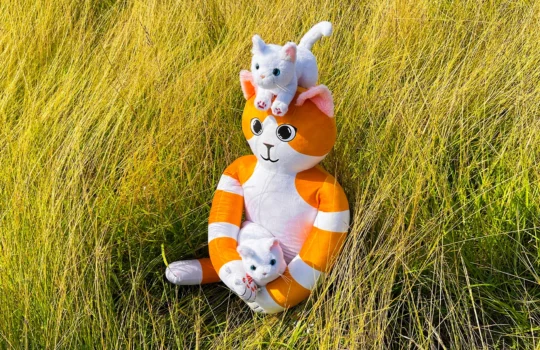Best Materials for Making Cuddly Plush Toys
Cuddly plush toys have been loved across generations. They bring comfort, joy, and a sense of security to children and even adults. Yet, not all plush toys feel the same. The difference lies in the materials used. Both the outer fabric and the inner filling play key roles in how soft, safe, and durable a plush toy will be.
Best Fabrics for Cuddly Plush Toys
Cotton
Cotton is a natural fiber and a common fabric choice for plush toys. It is breathable, soft, and gentle on sensitive skin. Organic cotton, in particular, avoids synthetic pesticides and chemicals, making it safer for babies. Cotton fabric can be dyed easily, offering a wide range of design possibilities.
However, cotton can shrink or wrinkle if not treated properly. Despite this, its natural feel and eco-friendly appeal make it a top choice, especially for eco-conscious buyers.
Plush Fabric (Minky)
Minky, also called plush fabric, is one of the most popular choices for high-quality cuddly plush toys. It has a silky-smooth texture and retains softness even after many washes. Minky fabrics are available in various textures—smooth, dotted, or embossed—that enhance tactile stimulation.
Parents often choose minky plush toys because of their long-lasting softness, making them a perfect bedtime companion.
Fleece
Fleece is a synthetic option that is lightweight, warm, and resistant to pilling. It holds bright colors well and is easy to clean. While it is less luxurious than minky, it remains a popular option for durable and colorful plush toys.
Recycled fleece is increasingly common, offering a more sustainable alternative without compromising softness.
Bamboo Fabric
Bamboo-based textiles are becoming more popular due to their eco-friendly properties. They are hypoallergenic, antibacterial, and softer than traditional cotton. In addition, bamboo fabrics are breathable and resist odors, making them suitable for plush toys meant for infants.
Velvet and Specialty Fabrics
Velvet and mohair are sometimes used in collectible plush toys. They add elegance and texture but are less common in everyday children’s toys. Their main strength lies in their premium, decorative appeal rather than practicality for constant cuddling.
Best Fillings for Cuddly Plush Toys
Polyester Fiberfill
Polyester fiberfill is the most widely used stuffing. It is lightweight, hypoallergenic, and retains its fluffiness. This filling helps plush toys keep their shape even after extended use and frequent washing.
It is also affordable and safe, making it the most practical choice for large-scale toy production. This is the most commonly used and frequently employed raw material.
Cotton Fill
Natural cotton is sometimes used as stuffing. It provides a soft and breathable interior, but it tends to clump over time. Because of this, it is better suited for handmade or decorative plush toys rather than heavily used ones.
Wool Stuffing
Wool offers natural firmness and resilience. It is sustainable and resists dust mites, but it may trigger allergies in sensitive individuals. Wool-filled toys are more common in artisanal and eco-conscious markets than in mass production.
Recycled Materials
Sustainable brands increasingly use recycled polyester or shredded textile scraps as stuffing. This reduces waste and gives old materials new life. Recycled fillings often perform similarly to traditional polyester while appealing to eco-conscious buyers.
Combining Fabric and Filling
Choosing the best material for cuddly plush toys requires balancing fabric and filling. The outer fabric should be soft, safe, and visually appealing, while the inner filling must ensure shape retention, fluffiness, and durability.
- For babies: Organic cotton or bamboo fabric paired with hypoallergenic polyester fiberfill provides softness and safety.
- For older children and adults: Minky fabric with polyester filling ensures long-lasting cuddles and durability.
- For collectors: Velvet or mohair combined with wool stuffing offers a premium look and feel.
All in all, the perfect plush toy material depends on the intended audience, safety standards, and sustainability goals.
Fimico’s Hugging Plush Toy
A great example of how premium materials enhance plush toys is the Orwa by Fimico. This toy combines:
- Super-soft plush fabric (minky): Ensuring a silky touch and long-lasting comfort.
- Hypoallergenic polyester filling: Providing fluffiness, durability, and safety for children.
- Eco-conscious design: Fimico integrates sustainable choices in their production, aligning with modern consumer values.
Because of these carefully chosen materials and unique design, Orwa is not only irresistibly cuddly but also safe and durable. It illustrates how the right blend of outer fabric and inner stuffing creates a plush toy that stands out in comfort and quality.
Conclusion
The best materials for making cuddly plush toys depend on the balance between outer fabrics and inner fillings. Cotton, bamboo, fleece, and especially minky provide excellent softness and safety. For stuffing, polyester fiberfill remains the most practical and reliable choice, though eco-friendly alternatives like recycled polyester and wool are valuable options.
When combined thoughtfully, these materials result in plush toys that are not only adorable but also safe, durable, and eco-friendly. Fimico’s Orwa toy is a perfect example of how careful material selection results in a plush companion designed to last. Meanwhile, Orwa use Fimico’s unique design to bring people a genuine and warm embrace from the plush toys.

